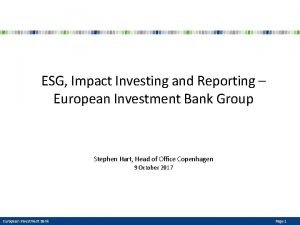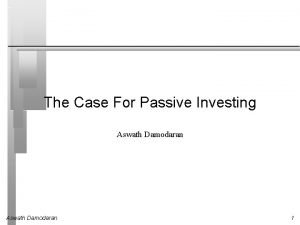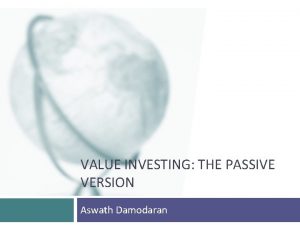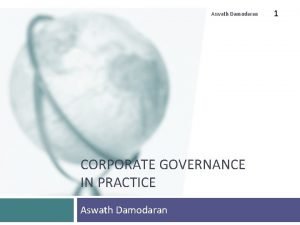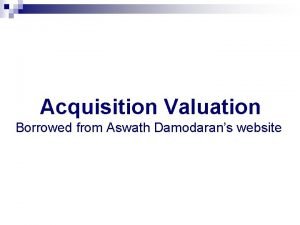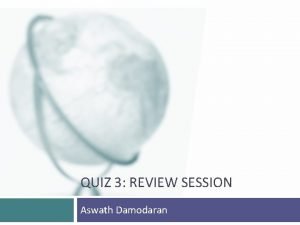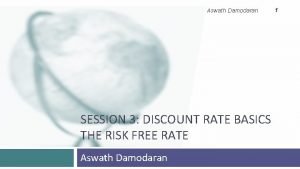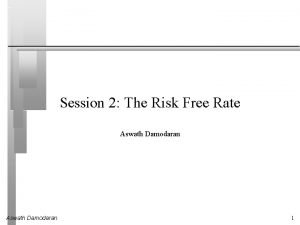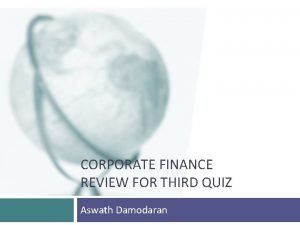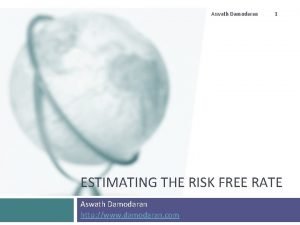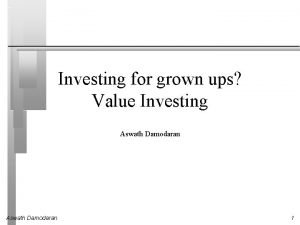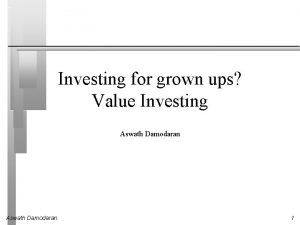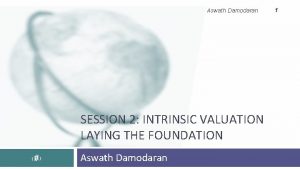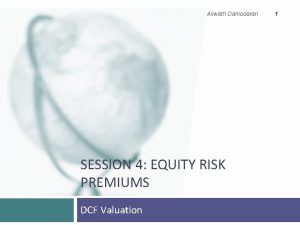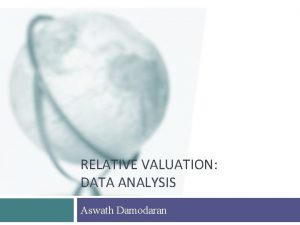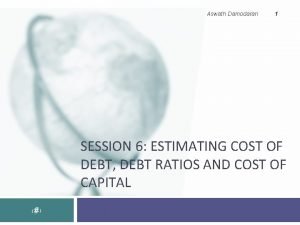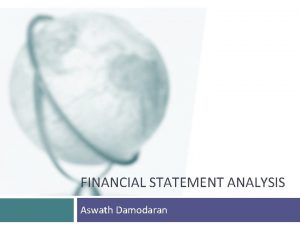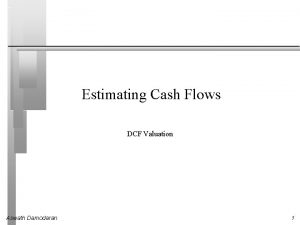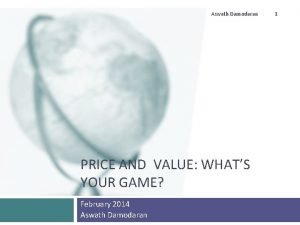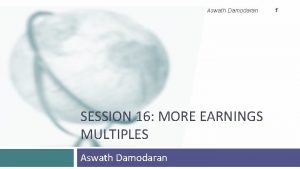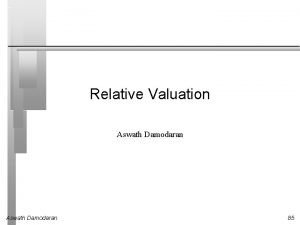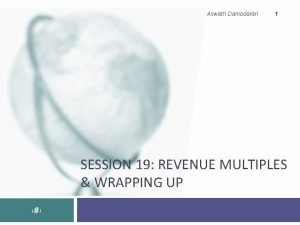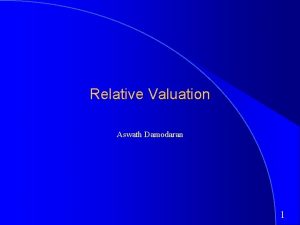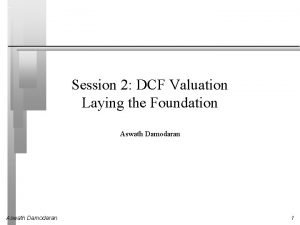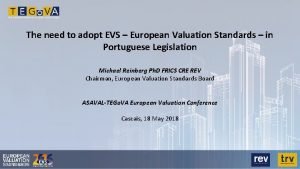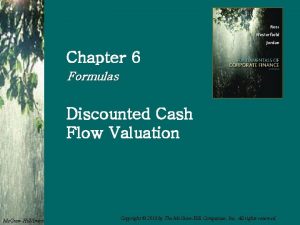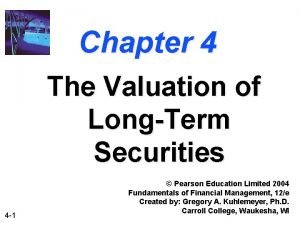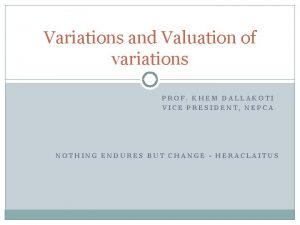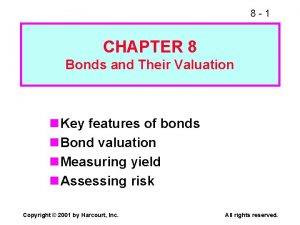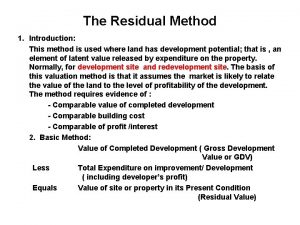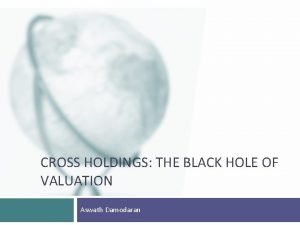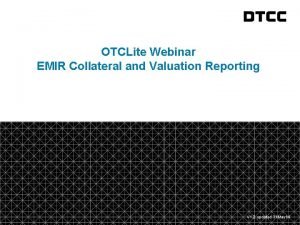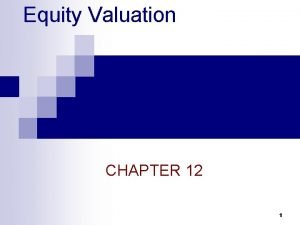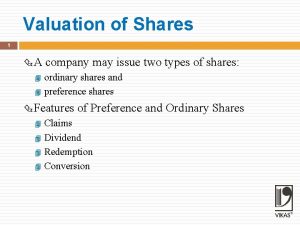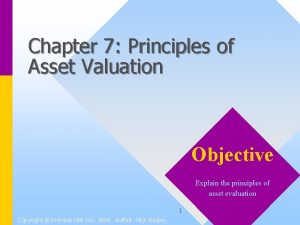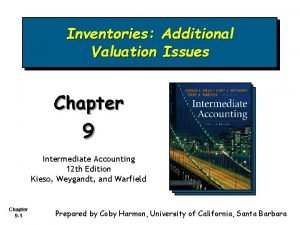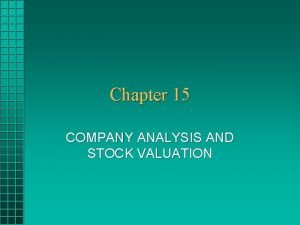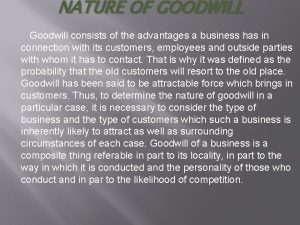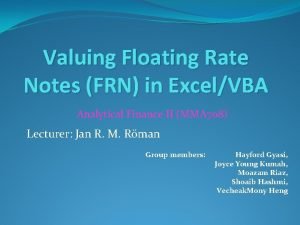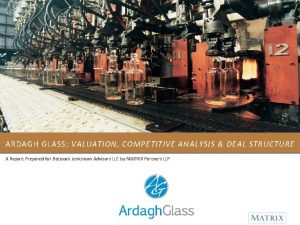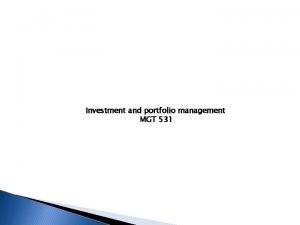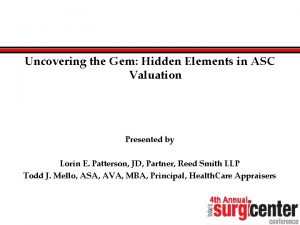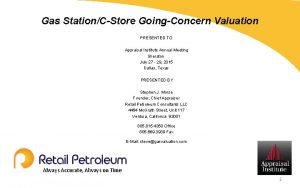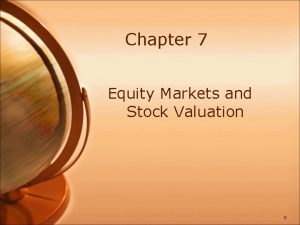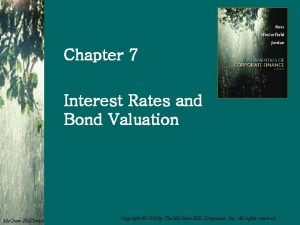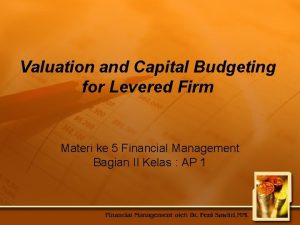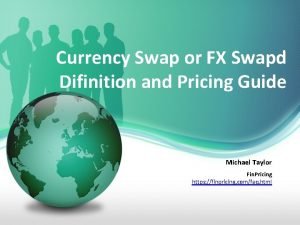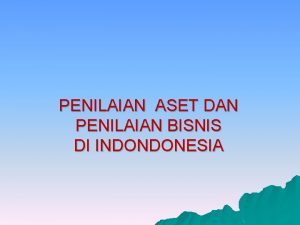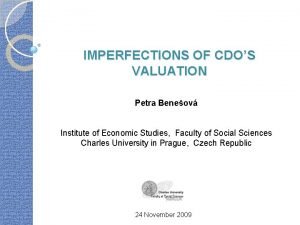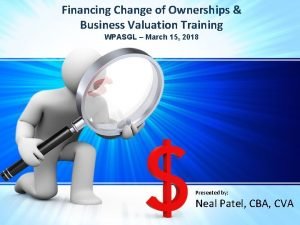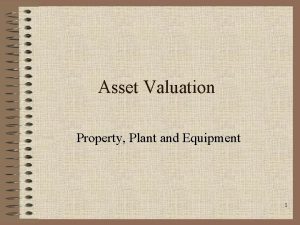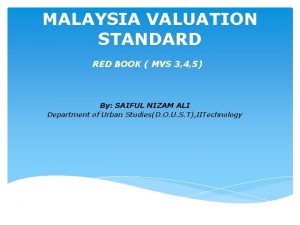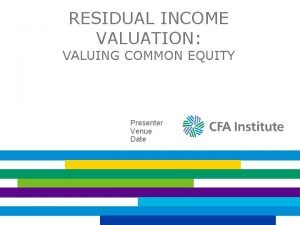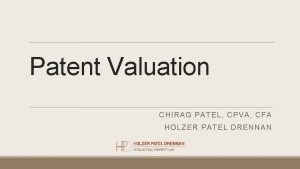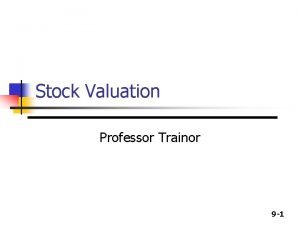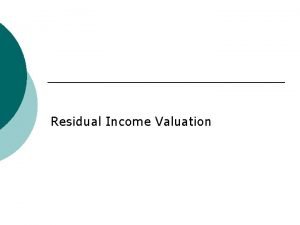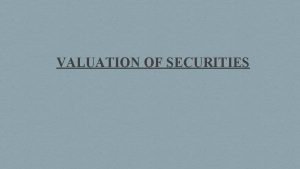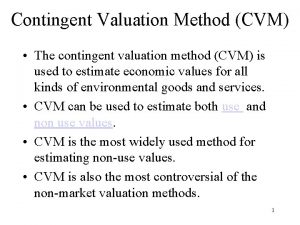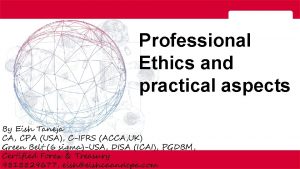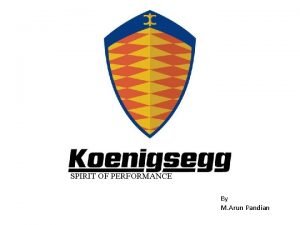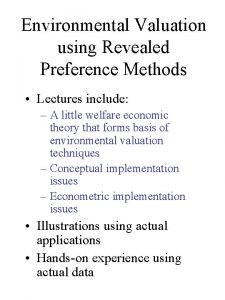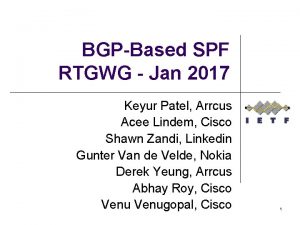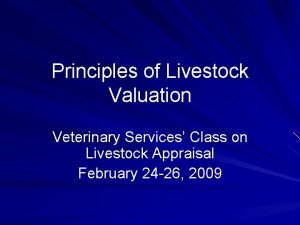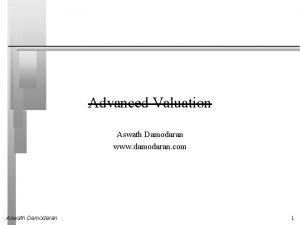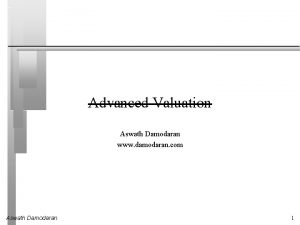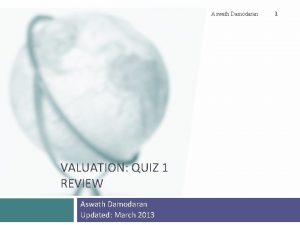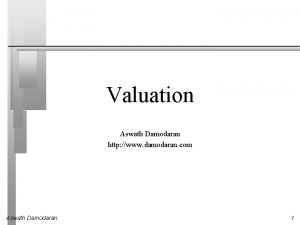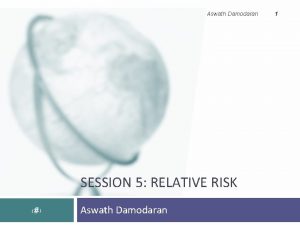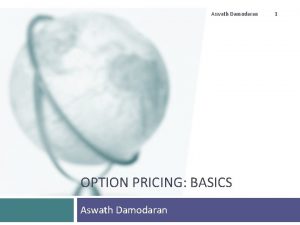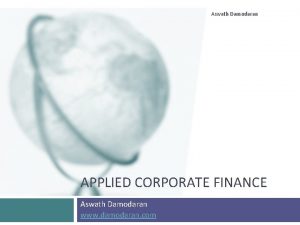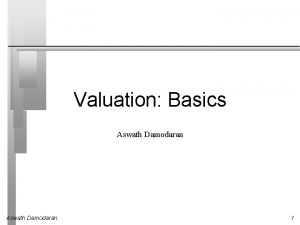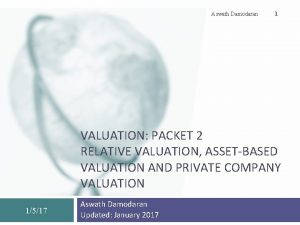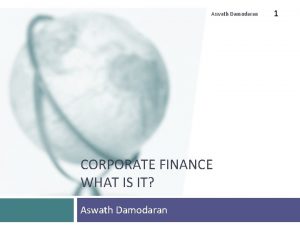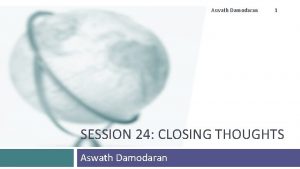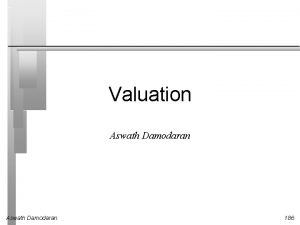Advanced Valuation Aswath Damodaran www damodaran com Aswath































































































- Slides: 95

Advanced Valuation Aswath Damodaran www. damodaran. com Aswath Damodaran 1

Some Initial Thoughts " One hundred thousand lemmings cannot be wrong" Graffiti Aswath Damodaran 2

Misconceptions about Valuation Myth 1: A valuation is an objective search for “true” value • • Myth 2. : A good valuation provides a precise estimate of value • • Truth 1. 1: All valuations are biased. The only questions are how much and in which direction. Truth 1. 2: The direction and magnitude of the bias in your valuation is directly proportional to who pays you and how much you are paid. Truth 2. 1: There are no precise valuations Truth 2. 2: The payoff to valuation is greatest when valuation is least precise. Myth 3: . The more quantitative a model, the better the valuation • • Aswath Damodaran Truth 3. 1: One’s understanding of a valuation model is inversely proportional to the number of inputs required for the model. Truth 3. 2: Simpler valuation models do much better than complex ones. 3

Approaches to Valuation Discounted cashflow valuation, relates the value of an asset to the present value of expected future cashflows on that asset. Relative valuation, estimates the value of an asset by looking at the pricing of 'comparable' assets relative to a common variable like earnings, cashflows, book value or sales. Contingent claim valuation, uses option pricing models to measure the value of assets that share option characteristics. Aswath Damodaran 4

Discounted Cash Flow Valuation What is it: In discounted cash flow valuation, the value of an asset is the present value of the expected cash flows on the asset. Philosophical Basis: Every asset has an intrinsic value that can be estimated, based upon its characteristics in terms of cash flows, growth and risk. Information Needed: To use discounted cash flow valuation, you need • • • to estimate the life of the asset to estimate the cash flows during the life of the asset to estimate the discount rate to apply to these cash flows to get present value Market Inefficiency: Markets are assumed to make mistakes in pricing assets across time, and are assumed to correct themselves over time, as new information comes out about assets. Aswath Damodaran 5

DCF Choices: Equity Valuation versus Firm Valuation: Value the entire business Equity valuation: Value just the equity claim in the business Aswath Damodaran 6

The Drivers of Value… Aswath Damodaran 7

Aswath Damodaran 8

Aswath Damodaran 9

Aswath Damodaran 10

Aswath Damodaran 11

Aswath Damodaran 12

Aswath Damodaran 13

I. Measure earnings right. . Aswath Damodaran 14

Operating Leases at Amgen in 2007 Amgen has lease commitments and its cost of debt (based on it’s A rating) is 5. 63%. Year 1 2 3 4 5 6 -12 Debt Value of leases = Commitment $96. 00 $95. 00 $102. 00 $98. 00 $87. 00 $107. 43 Present Value $90. 88 $85. 14 $86. 54 $78. 72 $66. 16 $462. 10 ($752 million prorated) $869. 55 Debt outstanding at Amgen = $7, 402 + $ 870 = $8, 272 million Adjusted Operating Income = Stated OI + Lease exp this year - Depreciation = 5, 071 m + 69 m - 870/12 = $5, 068 million (12 year life for assets) Approximate Operating income= $5, 071 m + 870 m (. 0563) = $ 5, 120 million Aswath Damodaran 15

Capitalizing R&D Expenses: Amgen R & D was assumed to have a 10 -year life. Year R&D Expense Unamortized portion Amortization this year Current 3366. 00 1. 00 3366. 00 -1 2314. 00 0. 90 2082. 60 $231. 40 -2 2028. 00 0. 80 1622. 40 $202. 80 -3 1655. 00 0. 70 1158. 50 $165. 50 -4 1117. 00 0. 60 670. 20 $111. 70 -5 865. 00 0. 50 432. 50 $86. 50 -6 845. 00 0. 40 338. 00 $84. 50 -7 823. 00 0. 30 246. 90 $82. 30 -8 663. 00 0. 20 132. 60 $66. 30 -9 631. 00 0. 10 63. 10 $63. 10 -10 558. 00 0. 00 $55. 80 Value of Research Asset = $10, 112. 80 $1, 149. 90 Adjusted Operating Income = $5, 120 + 3, 366 - 1, 150 = $7, 336 million Aswath Damodaran 16

II. Get the big picture (not the accounting one) when it comes to cap ex and working capital Capital expenditures should include • • Research and development expenses, once they have been re-categorized as capital expenses. Acquisitions of other firms, whether paid for with cash or stock. Working capital should be defined not as the difference between current assets and current liabilities but as the difference between noncash current assets and non-debt current liabilities. On both items, start with what the company did in the most recent year but do look at the company’s history and at industry averages. Aswath Damodaran 17

Amgen’s Net Capital Expenditures If we define capital expenditures broadly to include R&D and acquisitions: Accounting Capital Expenditures = - Accounting Depreciation = Accounting Net Cap Ex = Net R&D Cap Ex = (3366 -1150) = Acquisitions in 2006 = Total Net Capital Expenditures = $1, 218 million $ 963 million $ 255 million $2, 216 million $3, 975 million $ 6, 443 million Acquisitions have been a volatile item. Amgen was quiet on the acquisition front in 2004 and 2005 and had a significant acquisition in 2003. Aswath Damodaran 18

III. Betas do not come from regressions… Aswath Damodaran 19

Carry much noise… Aswath Damodaran 20

Look better for some companies, but looks can be deceptive… Aswath Damodaran 21

Bottom-up Betas Aswath Damodaran 22

Two examples… Amgen • • Tata Motors • • The unlevered beta for pharmaceutical firms is 1. 59. Using Amgen’s debt to equity ratio of 11%, the bottom up beta for Amgen is Bottom-up Beta = 1. 59 (1+ (1 -. 35)(. 11)) = 1. 73 The unlevered beta for automobile firms is 0. 98. Using Tata Motor’s debt to equity ratio of 33. 87%, the bottom up beta for Tata Motors is Bottom-up Beta = 0. 98 (1+ (1 -. 3399)(. 3387)) = 1. 20 A Question to ponder: Tata Motors recently made two big investments. • Tata Nano: Promoted as the cheapest car in the world, Tata Motors hopes that volume (especially in Asia) will make up for tight margins. • Jaguar/Land Rover: Tata acquired both firms, catering to luxury markets. What effect will these investments have on Tata Motor’s beta? Aswath Damodaran 23

B. The Historical Risk Premium Evidence from the United States 1928 -2011 1962 -2011 2002 -2011 Arithmetic Average Stocks - T. Bills Stocks - T. Bonds 7. 55% 5. 79% 2. 22% 2. 36% 5. 38% 3. 36% 2. 39% 2. 68% 3. 12% -1. 92% 6. 46% 8. 94% Geometric Average Stocks - T. Bills Stocks - T. Bonds 5. 62% 4. 10% 4. 02% 2. 35% 1. 08% -3. 61% What is the right premium? Go back as far as you can. Otherwise, the standard error in the estimate will be large. Be consistent in your use of a riskfree rate. Use arithmetic premiums for one-year estimates of costs of equity and geometric premiums for estimates of long term costs of equity. Aswath Damodaran 24

IV. And the past is not always a good indicator of the future It is standard practice to use historical premiums as forward looking premiums. : 1928 -2011 1962 -2011 2002 -2011 Arithmetic Average Stocks - T. Bills Stocks - T. Bonds 7. 55% 5. 79% 2. 22% 2. 36% 5. 38% 3. 36% 2. 39% 2. 68% 3. 12% -1. 92% 6. 46% 8. 94% Geometric Average Stocks - T. Bills Stocks - T. Bonds 5. 62% 4. 10% 4. 02% 2. 35% 1. 08% -3. 61% An alternative is to back out the premium from market prices: Aswath Damodaran 25

Implied Premiums in the US: 1960 -2010 Aswath Damodaran 26

The Anatomy of a Crisis: Implied ERP from September 12, 2008 to January 1, 2009 Aswath Damodaran 27

Implied Premium for India using the Sensex: April 2010 Level of the Index = 17559 FCFE on the Index = 3. 5% (Estimated FCFE for companies in index as % of market value of equity) Other parameters • • Riskfree Rate = 5% (Rupee) Expected Growth (in Rupee) – Next 5 years = 20% (Used expected growth rate in Earnings) – After year 5 = 5% Solving for the expected return: • • Aswath Damodaran Expected return on Equity = 11. 72% Implied Equity premium for India =11. 72% - 5% = 6. 72% 28

V. There is a downside to globalization… Emerging markets offer growth opportunities but they are also riskier. If we want to count the growth, we have to also consider the risk. Two ways of estimating the country risk premium: • Default spread on Country Bond: In this approach, the country equity risk premium is set equal to the default spread of the bond issued by the country. – Equity Risk Premium for mature market = 4. 5% – Equity Risk Premium for India = 4. 5% + 3% = 7. 5% • Adjusted for equity risk: The country equity risk premium is based upon the volatility of the equity market relative to the government bond rate. Country risk premium= Default Spread* Country Equity / Country Bond – Standard Deviation in Sensex = 30% – Standard Deviation in Indian government bond= 20% – Default spread on Indian Bond= 3% – Total equity risk premium for India = 4. 5% + 3% (30/20) = 9% Aswath Damodaran 29

Country Risk Premiums January 2012 Canada United States of America Argentina Belize Bolivia Brazil Chile Colombia Costa Rica Ecuador El Salvador Guatemala Honduras Mexico Nicaragua Panama Paraguay Peru Uruguay Venezuela Aswath Damodaran 6. 00% 15. 00% 12. 00% 8. 63% 7. 05% 9. 00% 18. 75% 10. 13% 9. 60% 13. 50% 8. 25% 15. 00% 9. 00% 12. 00% 9. 60% 12. 00% Austria [1] Belgium [1] Cyprus [1] Denmark Finland [1] France [1] Germany [1] Greece [1] Iceland Ireland [1] Italy [1] Malta [1] Netherlands [1] Norway Portugal [1] Spain [1] Sweden Switzerland United Kingdom Angola Botswana Egypt Mauritius Morocco Namibia South Africa Tunisia 6. 00% 7. 05% 9. 00% 6. 00% 9. 60% 7. 50% 6. 00% 10. 13% 7. 28% 6. 00% 10. 88% 7. 50% 13. 50% 8. 63% 9. 60% 9. 00% 7. 73% 9. 00% Albania Armenia Azerbaijan Belarus Bosnia and Herzegovina Bulgaria Croatia Czech Republic Estonia Georgia Hungary Kazakhstan Latvia Lithuania Moldova Montenegro Poland Romania Russia Slovakia Slovenia [1] Ukraine 12. 00% 10. 13% 9. 60% 15. 00% 13. 50% 8. 63% 9. 00% 7. 28% 10. 88% 9. 60% 8. 63% 9. 00% 8. 25% 15. 00% 10. 88% 7. 50% 9. 00% 8. 25% 7. 28% 13. 50% Bahrain 8. 25% Israel 7. 28% Jordan 10. 13% Kuwait 6. 75% Lebanon 12. 00% Oman 7. 28% Qatar 6. 75% Saudi Arabia 7. 05% Senegal 12. 00% United Arab Emirates 6. 75% Bangladesh Cambodia China Fiji Islands Hong Kong India Indonesia Japan Korea Macao Malaysia Mongolia Pakistan Papua New Guinea Philippines Singapore Sri Lanka Taiwan Thailand Turkey Vietnam Australia New Zealand 10. 88% 13. 50% 7. 05% 12. 00% 6. 38% 9. 00% 9. 60% 7. 05% 7. 28% 7. 05% 7. 73% 12. 00% 15. 00% 12. 00% 10. 13% 6. 00% 12. 00% 7. 05% 8. 25% 10. 13% 12. 00% 6. 00% 30

VI. And it is not just emerging market companies that are exposed to this risk. . If we treat country risk as a separate risk factor and allow firms to have different exposures to country risk (perhaps based upon the proportion of their revenues come from non-domestic sales) E(Return)=Riskfree Rate+ b (US premium) + (Country ERP) The easiest and most accessible data is on revenues. Most companies break their revenues down by region. One simplistic solution would be to do the following: = % of revenues domesticallyfirm/ % of revenues domesticallyavg firm Consider two firms – Tata Motors and Tata Consulting Services. In 2008 -09, Tata Motors got about 91. 37% of its revenues in India and TCS got 7. 62%. The average Indian firm gets about 80% of its revenues in India: Tata Motors = 91%/80% = 1. 14 TCS = 7. 62%/80% = 0. 09 There are two implications • A company’s risk exposure is determined by where it does business and not by where it is located • Firms might be able to actively manage their country risk exposures Aswath Damodaran 31

Estimating lambdas: Tata Motors versus TCS Tata Motors % of production/operations in India High 91. 37% (in 2009) Estimated 70% (in % of revenues in India 2010) Lambda Flexibility in moving operations Aswath Damodaran TCS High 7. 62% 0. 80 0. 20 Low. Significant physical assets. High. Human capital is mobile. 32

VII. Discount rates can (and often should) change over time… The inputs into the cost of capital - the cost of equity (beta), the cost of debt (default risk) and the debt ratio - can change over time. For younger firms, they should change over time. At the minimum, they should change when you get to your terminal year to inputs that better reflect a mature firm. Aswath Damodaran 33

VIII. Growth has to be earned (not endowed or estimated) Aswath Damodaran 34

IX. All good things come to an end. . And the terminal value is not an ATM… Aswath Damodaran 35

Terminal Value and Growth Aswath Damodaran 36

X. The loose ends matter… Aswath Damodaran 37

1. The Value of Cash An Exercise in Cash Valuation Enterprise Value Cash Return on Capital Cost of Capital Trades in Company A $ 1 billion $ 100 mil 10% US Company B $ 1 billion $ 100 mil 5% 10% US Company C $ 1 billion $ 100 mil 22% 12% Argentina In which of these companies is cash most likely to trade at face value, at a discount and at a premium? Aswath Damodaran 38

Cash: Discount or Premium? Aswath Damodaran 39

2. Dealing with Holdings in Other firms Holdings in other firms can be categorized into • • • Minority passive holdings, in which case only the dividend from the holdings is shown in the balance sheet Minority active holdings, in which case the share of equity income is shown in the income statements Majority active holdings, in which case the financial statements are consolidated. We tend to be sloppy in practice in dealing with cross holdings. After valuing the operating assets of a firm, using consolidated statements, it is common to add on the balance sheet value of minority holdings (which are in book value terms) and subtract out the minority interests (again in book value terms), representing the portion of the consolidated company that does not belong to the parent company. Aswath Damodaran 40

How to value holdings in other firms. . In a perfect world, we would strip the parent company from its subsidiaries and value each one separately. The value of the combined firm will be • Value of parent company + Proportion of value of each subsidiary To do this right, you will need to be provided detailed information on each subsidiary to estimated cash flows and discount rates. Aswath Damodaran 41

Two compromise solutions… The market value solution: When the subsidiaries are publicly traded, you could use their traded market capitalizations to estimate the values of the cross holdings. You do risk carrying into your valuation any mistakes that the market may be making in valuation. The relative value solution: When there are too many cross holdings to value separately or when there is insufficient information provided on cross holdings, you can convert the book values of holdings that you have on the balance sheet (for both minority holdings and minority interests in majority holdings) by using the average price to book value ratio of the sector in which the subsidiaries operate. Aswath Damodaran 42

Tata Motor’s Cross Holdings Aswath Damodaran 43

3. Other Assets that have not been counted yet. . Unutilized assets: If you have assets or property that are not being utilized (vacant land, for example), you have not valued it yet. You can assess a market value for these assets and add them on to the value of the firm. Overfunded pension plans: If you have a defined benefit plan and your assets exceed your expected liabilities, you could consider the over funding with two caveats: • • Collective bargaining agreements may prevent you from laying claim to these excess assets. There are tax consequences. Often, withdrawals from pension plans get taxed at much higher rates. Do not double count an asset. If you count the income from an asset in your cashflows, you cannot count the market value of the asset in your value. Aswath Damodaran 44

4. A Discount for Complexity: An Experiment Company A Company B Operating Income $ 1 billion Tax rate 40% ROIC 10% Expected Growth 5% 5% Cost of capital 8% 8% Business Mix Single Business Multiple Businesses Holdings Simple Complex Accounting Transparent Opaque Which firm would you value more highly? Aswath Damodaran 45

Measuring Complexity: Volume of Data in Financial Statements Aswath Damodaran 46

Measuring Complexity: A Complexity Score Item Operating Income Follow-up Question Number of businesses (with more than 10% of revenues) = 2. One-time income and expenses Percent of operating income = 3. Income from unspecified sources Percent of operating income = 4. Items in income statement that are volatile. Percent of operating income = Tax Rate 1. Income from multiple locales Percent of revenues from non-domestic locales = 2. Different tax and reporting books Yes or No 3. Headquarters in tax havens Yes or No 4. Volatile effective tax rate Yes or No Capital Expenditures 1. Volatile capital expenditures Yes or No 2. Frequent and large acquisitions Yes or No 3. Stock payment for acquisitions and investments Yes or No Working capital 1. Unspecified current assets and current liabilities Yes or No 2. Volatile working capital items Yes or No Expected Growth rate 1. Off-balance sheet assets and liabilities (operating leases and R&D) Yes or No Cost of capital No-operating assets Firm to Equity value Per share value Factors 1. Multiple Businesses 2. Substantial stock buybacks 3. Changing return on capital over time 4. Unsustainably high return 1. Multiple businesses 2. Operations in emerging markets 3. Is the debt market traded? 4. Does the company have a rating? 5. Does the company have off-balance sheet debt? Minority holdings as percent of book assets Consolidation of subsidiaries Shares with different voting rights Equity options outstanding Aswath Damodaran Answer Weighting factor Gerdau Score GE Score 1 10% 0% 15% 70% No No Yes Yes 2. 00 10. 00 5. 00 3. 00 Yes=3 Yes=2 Yes=4 2 1 0 0. 75 2. 1 0 0 2 2 4 30 0. 8 1. 2 1 1. 8 3 0 0 2 4 No Yes=4 0 4 No Yes=3 Yes=2 0 2 No Yes or No No Is your return on capital volatile? Yes Is your firm's ROC much higher than industry average? No Number of businesses (more than 10% of revenues) = 1 Percent of revenues= 50% Yes or No No Yes or No Yes=3 Yes=5 1. 00 5. 00 No=2 0 0 5 0 1 2. 5 2 0 3 3 5 0 20 2. 5 0 0 Yes=5 20. 00 Yes = 10 10. 00 0 0 12. 6 10 0 48. 95 5 0. 8 1. 2 0 0. 25 90. 55 Yes or No Minority holdings as percent of book assets Minority interest as percent of book value of equity Does the firm have shares with different voting rights? Options outstanding as percent of shares Complexity Score = No 0% 63% Yes 0% 47

Dealing with Complexity In Discounted Cashflow Valuation The Aggressive Analyst: Trust the firm to tell the truth and value the firm based upon the firm’s statements about their value. The Conservative Analyst: Don’t value what you cannot see. The Compromise: Adjust the value for complexity • • Adjust cash flows for complexity Adjust the discount rate for complexity Adjust the expected growth rate/ length of growth period Value the firm and then discount value for complexity In relative valuation In a relative valuation, you may be able to assess the price that the market is charging for complexity: With the hundred largest market cap firms, for instance: PBV = 0. 65 + 15. 31 ROE – 0. 55 Beta + 3. 04 Expected growth rate – 0. 003 # Pages in 10 K Aswath Damodaran 48

5. The Value of Synergy Aswath Damodaran 49

Valuing Synergy (1) the firms involved in the merger are valued independently, by discounting expected cash flows to each firm at the weighted average cost of capital for that firm. (2) the value of the combined firm, with no synergy, is obtained by adding the values obtained for each firm in the first step. (3) The effects of synergy are built into expected growth rates and cashflows, and the combined firm is re-valued with synergy. Value of Synergy = Value of the combined firm, with synergy - Value of the combined firm, without synergy Aswath Damodaran 50

Valuing Synergy: P&G + Gillette Aswath Damodaran 51

6. Brand name, great management, superb product …Are we short changing the intangibles? There is often a temptation to add on premiums for intangibles. Among them are • • Brand name Great management Loyal workforce Technological prowess There are two potential dangers: • • For some assets, the value may already be in your value and adding a premium will be double counting. For other assets, the value may be ignored but incorporating it will not be easy. Aswath Damodaran 52

Valuing Brand Name Current Revenues = Length of high-growth period Reinvestment Rate = Operating Margin (after-tax) Sales/Capital (Turnover ratio) Return on capital (after-tax) Growth rate during period (g) = Cost of Capital during period = Stable Growth Period Growth rate in steady state = Return on capital = Reinvestment Rate = Cost of Capital = Value of Firm = Aswath Damodaran Coca Cola $21, 962. 00 10 50% 15. 57% 1. 34 20. 84% 10. 42% 7. 65% With Cott Margins $21, 962. 00 10 50% 5. 28% 1. 34 7. 06% 3. 53% 7. 65% 4. 00% 7. 65% 52. 28% 7. 65% $79, 611. 25 4. 00% 7. 65% 52. 28% 7. 65% $15, 371. 24 53

7. Be circumspect about defining debt for cost of capital purposes… General Rule: Debt generally has the following characteristics: • • • Defined as such, debt should include • • Commitment to make fixed payments in the future The fixed payments are tax deductible Failure to make the payments can lead to either default or loss of control of the firm to the party to whom payments are due. All interest bearing liabilities, short term as well as long term All leases, operating as well as capital Debt should not include • Aswath Damodaran Accounts payable or supplier credit 54

But should consider other potential liabilities when getting to equity value… If you have under funded pension fund or health care plans, you should consider the under funding at this stage in getting to the value of equity. • • If you do so, you should not double count by also including a cash flow line item reflecting cash you would need to set aside to meet the unfunded obligation. You should not be counting these items as debt in your cost of capital calculations…. If you have contingent liabilities - for example, a potential liability from a lawsuit that has not been decided - you should consider the expected value of these contingent liabilities • Aswath Damodaran Value of contingent liability = Probability that the liability will occur * Expected value of liability 55

8. The Value of Control The value of the control premium that will be paid to acquire a block of equity will depend upon two factors • Probability that control of firm will change: This refers to the probability that incumbent management will be replaced. this can be either through acquisition or through existing stockholders exercising their muscle. • Value of Gaining Control of the Company: The value of gaining control of a company arises from two sources - the increase in value that can be wrought by changes in the way the company is managed and run, and the side benefits and perquisites of being in control Value of Gaining Control = Present Value (Value of Company with change in control Value of company without change in control) + Side Benefits of Control Aswath Damodaran 56

Aswath Damodaran 57

Aswath Damodaran 58

Aswath Damodaran 59

Value of Control and the Value of Voting Rights The value of control at Adris Grupa can be computed as the difference between the status quo value (5469) and the optimal value (5735). The value of a voting share derives entirely from the capacity you have to change the way the firm is run. In this case, we have two values for Adris Grupa’s Equity. Status Quo Value of Equity = 5, 469 million HKR All shareholders, common and preferred, get an equal share of the status quo value. Value for a non-voting share = 5469/(9. 616+6. 748) = 334 HKR/share Optimal value of Equity = 5, 735 million HKR Value of control at Adris Grupa = 5, 735 – 5469 = 266 million HKR Only voting shares get a share of this value of control Value per voting share =334 HKR + 266/9. 616 = 362 HKR Aswath Damodaran 60

9. Distress and the Going Concern Assumption Traditional valuation techniques are built on the assumption of a going concern, i. e. , a firm that has continuing operations and there is no significant threat to these operations. • • In discounted cashflow valuation, this going concern assumption finds its place most prominently in the terminal value calculation, which usually is based upon an infinite life and ever-growing cashflows. In relative valuation, this going concern assumption often shows up implicitly because a firm is valued based upon how other firms - most of which are healthy are priced by the market today. When there is a significant likelihood that a firm will not survive the immediate future (next few years), traditional valuation models may yield an over-optimistic estimate of value. Aswath Damodaran 61

9. Distress and the Going Concern Assumption Traditional valuation techniques are built on the assumption of a going concern, i. e. , a firm that has continuing operations and there is no significant threat to these operations. • • In discounted cashflow valuation, this going concern assumption finds its place most prominently in the terminal value calculation, which usually is based upon an infinite life and ever-growing cashflows. In relative valuation, this going concern assumption often shows up implicitly because a firm is valued based upon how other firms - most of which are healthy are priced by the market today. When there is a significant likelihood that a firm will not survive the immediate future (next few years), traditional valuation models may yield an over-optimistic estimate of value. Aswath Damodaran 62

Aswath Damodaran 63

The Distress Factor In February 2009, LVS was rated B+ by S&P. Historically, 28. 25% of B+ rated bonds default within 10 years. LVS has a 6. 375% bond, maturing in February 2015 (7 years), trading at $529. If we discount the expected cash flows on the bond at the riskfree rate, we can back out the probability of distress from the bond price: Solving for the probability of bankruptcy, we get: Distress = Annual probability of default = 13. 54% • • If LVS is becomes distressed: • • Cumulative probability of surviving 10 years = (1 -. 1354)10 = 23. 34% Cumulative probability of distress over 10 years = 1 -. 2334 =. 7666 or 76. 66% Expected distress sale proceeds = $2, 769 million < Face value of debt Expected equity value/share = $0. 00 Expected value per share = $8. 12 (1 -. 7666) + $0. 00 (. 7666) = $1. 92 Aswath Damodaran 64

10. Analyzing the Effect of Illiquidity on Value Investments which are less liquid should trade for less than otherwise similar investments which are more liquid. The size of the illiquidity discount should vary across firms and also across time. The conventional practice of relying upon studies of restricted stocks or IPOs will fail sooner rather than later. • • Aswath Damodaran Restricted stock studies are based upon small samples of troubled firms The discounts observed in IPO studies are too large for these to be arms length transactions. They just do not make sense. 65

Illiquidity Discounts from Bid-Ask Spreads Using data from the end of 2000, for instance, we regressed the bid-ask spread against annual revenues, a dummy variable for positive earnings (DERN: 0 if negative and 1 if positive), cash as a percent of firm value and trading volume. Spread = 0. 145 – 0. 0022 ln (Annual Revenues) -0. 015 (DERN) – 0. 016 (Cash/Firm Value) – 0. 11 ($ Monthly trading volume/ Firm Value) We could substitute in the revenues of Kristin Kandy ($5 million), the fact that it has positive earnings and the cash as a percent of revenues held by the firm (8%): Spread = 0. 145 – 0. 0022 ln (Annual Revenues) -0. 015 (DERN) – 0. 016 (Cash/Firm Value) – 0. 11 ($ Monthly trading volume/ Firm Value) = 0. 145 – 0. 0022 ln (5) -0. 015 (1) – 0. 016 (. 08) – 0. 11 (0) =. 12. 52% Based on this approach, we would estimate an illiquidity discount of 12. 52% for Kristin Kandy. Aswath Damodaran 66

Relative Valuation Aswath Damodaran 67

Relative valuation is pervasive… Most asset valuations are relative. Most equity valuations on Wall Street are relative valuations. • • • Almost 85% of equity research reports are based upon a multiple and comparables. More than 50% of all acquisition valuations are based upon multiples Rules of thumb based on multiples are not only common but are often the basis for final valuation judgments. While there are more discounted cashflow valuations in consulting and corporate finance, they are often relative valuations masquerading as discounted cash flow valuations. • • Aswath Damodaran The objective in many discounted cashflow valuations is to back into a number that has been obtained by using a multiple. The terminal value in a significant number of discounted cashflow valuations is estimated using a multiple. 68

The Reasons for the allure… “If you think I’m crazy, you should see the guy who lives across the hall” Jerry Seinfeld talking about Kramer in a Seinfeld episode “ A little inaccuracy sometimes saves tons of explanation” H. H. Munro “ If you are going to screw up, make sure that you have lots of company” Ex-portfolio manager Aswath Damodaran 69

The Four Steps to Deconstructing Multiples Define the multiple • Describe the multiple • Too many people who use a multiple have no idea what its cross sectional distribution is. If you do not know what the cross sectional distribution of a multiple is, it is difficult to look at a number and pass judgment on whether it is too high or low. Analyze the multiple • In use, the same multiple can be defined in different ways by different users. When comparing and using multiples, estimated by someone else, it is critical that we understand how the multiples have been estimated It is critical that we understand the fundamentals that drive each multiple, and the nature of the relationship between the multiple and each variable. Apply the multiple • Aswath Damodaran Defining the comparable universe and controlling for differences is far more difficult in practice than it is in theory. 70

Definitional Tests Is the multiple consistently defined? • Proposition 1: Both the value (the numerator) and the standardizing variable ( the denominator) should be to the same claimholders in the firm. In other words, the value of equity should be divided by equity earnings or equity book value, and firm value should be divided by firm earnings or book value. Is the multiple uniformly estimated? • • Aswath Damodaran The variables used in defining the multiple should be estimated uniformly across assets in the “comparable firm” list. If earnings-based multiples are used, the accounting rules to measure earnings should be applied consistently across assets. The same rule applies with book-value based multiples. 71

Example 1: Price Earnings Ratio: Definition PE = Market Price per Share / Earnings per Share There a number of variants on the basic PE ratio in use. They are based upon how the price and the earnings are defined. Price: is usually the current price is sometimes the average price for the year EPS: earnings per share in most recent financial year earnings per share in trailing 12 months (Trailing PE) forecasted earnings per share next year (Forward PE) forecasted earnings per share in future year Aswath Damodaran 72

Example 2: Enterprise Value /EBITDA Multiple The enterprise value to EBITDA multiple is obtained by netting cash out against debt to arrive at enterprise value and dividing by EBITDA. Why do we net out cash from firm value? What happens if a firm has cross holdings which are categorized as: • • Aswath Damodaran Minority interests? Majority active interests? 73

Descriptive Tests What is the average and standard deviation for this multiple, across the universe (market)? What is the median for this multiple? • How large are the outliers to the distribution, and how do we deal with the outliers? • The median for this multiple is often a more reliable comparison point. Throwing out the outliers may seem like an obvious solution, but if the outliers all lie on one side of the distribution (they usually are large positive numbers), this can lead to a biased estimate. Are there cases where the multiple cannot be estimated? Will ignoring these cases lead to a biased estimate of the multiple? How has this multiple changed over time? Aswath Damodaran 74

Looking at the distribution of PE ratios… US Stocks in January 2011 Aswath Damodaran 75

PE: Deciphering the Distribution Aswath Damodaran 76

Comparing PE Ratios: US, Europe, Japan and Emerging Markets Aswath Damodaran 77

And 6 times EBITDA may not be cheap… Aswath Damodaran 78

Analytical Tests What are the fundamentals that determine and drive these multiples? • • Proposition 2: Embedded in every multiple are all of the variables that drive every discounted cash flow valuation - growth, risk and cash flow patterns. In fact, using a simple discounted cash flow model and basic algebra should yield the fundamentals that drive a multiple How do changes in these fundamentals change the multiple? • • Aswath Damodaran The relationship between a fundamental (like growth) and a multiple (such as PE) is seldom linear. For example, if firm A has twice the growth rate of firm B, it will generally not trade at twice its PE ratio Proposition 3: It is impossible to properly compare firms on a multiple, if we do not know the nature of the relationship between fundamentals and the multiple. 79

PE Ratio: Understanding the Fundamentals To understand the fundamentals, start with a basic equity discounted cash flow model. With the dividend discount model, Dividing both sides by the current earnings per share, If this had been a FCFE Model, Aswath Damodaran 80

The Determinants of Multiples… Aswath Damodaran 81

Application Tests Given the firm that we are valuing, what is a “comparable” firm? • • While traditional analysis is built on the premise that firms in the same sector are comparable firms, valuation theory would suggest that a comparable firm is one which is similar to the one being analyzed in terms of fundamentals. Proposition 4: There is no reason why a firm cannot be compared with another firm in a very different business, if the two firms have the same risk, growth and cash flow characteristics. Given the comparable firms, how do we adjust for differences across firms on the fundamentals? • Aswath Damodaran Proposition 5: It is impossible to find an exactly identical firm to the one you are valuing. 82

An Example: Comparing PE Ratios across a Sector: PE Aswath Damodaran 83

PE, Growth and Risk Dependent variable is: R squared = 66. 2% PE R squared (adjusted) = 63. 1% Variable Coefficient SE t-ratio Constant 13. 1151 3. 471 3. 78 Growth rate 121. 223 19. 27 6. 29 Emerging Market -13. 8531 3. 606 -3. 84 Emerging Market is a dummy: 1 if emerging market 0 if not Aswath Damodaran prob 0. 0010 ≤ 0. 0001 0. 0009 84

Is Telebras under valued? Predicted PE = 13. 12 + 121. 22 (. 075) - 13. 85 (1) = 8. 35 At an actual price to earnings ratio of 8. 9, Telebras is slightly overvalued. Aswath Damodaran 85

Amgen’s Relative Value Aswath Damodaran 86

The Drivers of PE Ratios… Regressing PE ratios against growth, we get • • • PE = 14. 86 + 0. 85 (Expected growth rate) R 2 = 49% Plugging in Amgen’s expected growth rate of 15%, we get PE = 14. 86 + 0. 85 (15) = 27. 61 At 16 times earnings, Amgen seems to be significantly undervalued by almost 40% relative to the rest of the pharmaceutical sector. Aswath Damodaran 87

Comparisons to the entire market: Why not? In contrast to the 'comparable firm' approach, the information in the entire cross-section of firms can be used to predict PE ratios. The simplest way of summarizing this information is with a multiple regression, with the PE ratio as the dependent variable, and proxies for risk, growth and payout forming the independent variables. Aswath Damodaran 88

PE Ratio: Standard Regression for US stocks - January 2011 Aswath Damodaran 89

Amgen valued relative to the market Plugging in Amgen’s numbers into the January 2007 market regression: • • Expected growth rate = 15% Beta = 0. 85 Payout ratio = 0% Predicted PE = 10. 645 + 1. 176 (15) - 2. 621 (0. 85) = 26. 06 Again, at 16 times earnings, Amgen seems to be significantly undervalued, relative to how the market is pricing all other stocks. Aswath Damodaran 90

Fundamentals hold in every market: PE regressions across markets… Region Regression – January 2011 R squared Europe PE = 11. 55 + 53. 32 Expected Growth + 6. 00 Payout -1. 35 Beta 29. 8% Japan PE = 16. 60 + 17. 24 Expected Growth + 14. 68 Beta 19. 6% Emerging Markets PE = 19. 47+ 17. 10 Expected Growth + 2. 45 Payout 7. 8% Aswath Damodaran 91

Choosing Between the Multiples As presented in this section, there are dozens of multiples that can be potentially used to value an individual firm. In addition, relative valuation can be relative to a sector (or comparable firms) or to the entire market (using the regressions, for instance) Since there can be only one final estimate of value, there are three choices at this stage: • • • Aswath Damodaran Use a simple average of the valuations obtained using a number of different multiples Use a weighted average of the valuations obtained using a nmber of different multiples Choose one of the multiples and base your valuation on that multiple 92

Picking one Multiple This is usually the best way to approach this issue. While a range of values can be obtained from a number of multiples, the “best estimate” value is obtained using one multiple. The multiple that is used can be chosen in one of two ways: • • • Aswath Damodaran Use the multiple that best fits your objective. Thus, if you want the company to be undervalued, you pick the multiple that yields the highest value. Use the multiple that has the highest R-squared in the sector when regressed against fundamentals. Thus, if you have tried PE, PBV, PS, etc. and run regressions of these multiples against fundamentals, use the multiple that works best at explaining differences across firms in that sector. Use the multiple that seems to make the most sense for that sector, given how value is measured and created. 93

Conventional usage… Sector Multiple Used Rationale Cyclical Manufacturing PE, Relative PE Often with normalized earnings Growth firms PEG ratio Big differences in growth rates Young growth firms w/ losses Revenue Multiples What choice do you have? Infrastructure EV/EBITDA Early losses, big DA REIT P/CFE (where CFE = Net income + Depreciation) Big depreciation charges on real estate Financial Services Price/ Book equity Marked to market? Retailing Revenue multiples Margins equalize sooner or later Aswath Damodaran 94

Back to Lemmings. . . Aswath Damodaran 95
 Aswath damodaran
Aswath damodaran Cơm
Cơm Dậy thổi cơm mua thịt cá
Dậy thổi cơm mua thịt cá Aswath damodaran esg
Aswath damodaran esg Aswath damodaran
Aswath damodaran Aswath damodaran value investing
Aswath damodaran value investing Aswath damodaran age
Aswath damodaran age Aswath damodaran website
Aswath damodaran website Aswath damodaran value investing
Aswath damodaran value investing Damodaran on valuation review
Damodaran on valuation review Damodaran discount rates
Damodaran discount rates Aswath damodaran net worth
Aswath damodaran net worth Default spread damodaran
Default spread damodaran Aswath damodaran review
Aswath damodaran review Default spread damodaran
Default spread damodaran Damodaran portfolio
Damodaran portfolio Aswath damodaran statistics
Aswath damodaran statistics Aswath damodaran portfolio
Aswath damodaran portfolio Aswath damodaran value investing
Aswath damodaran value investing Aswath damodaran value investing
Aswath damodaran value investing Aswath damodaran intrinsic value
Aswath damodaran intrinsic value Damodaran discount rate
Damodaran discount rate Types of investment philosophies
Types of investment philosophies Damodaran.com
Damodaran.com Data damodaran
Data damodaran Damodaran cost of debt
Damodaran cost of debt Aswath damodaran accounting
Aswath damodaran accounting Damodaran
Damodaran Aswath damodaran dcf
Aswath damodaran dcf Aswath damodaran intrinsic value
Aswath damodaran intrinsic value Ebitda multiples for trucking companies
Ebitda multiples for trucking companies Www.damodaran.com
Www.damodaran.com Relative valuation damodaran
Relative valuation damodaran Damodaran revenue multiples
Damodaran revenue multiples Aswath damodaran
Aswath damodaran Fixed income introduction
Fixed income introduction Relative valuation
Relative valuation Damodaran private company valuation
Damodaran private company valuation Dcf aswath
Dcf aswath European valuation standards
European valuation standards Contingent valuation method
Contingent valuation method Chapter 6 discounted cash flow valuation
Chapter 6 discounted cash flow valuation Valuing private companies
Valuing private companies Myweb valuation
Myweb valuation Valuation of long term securities
Valuation of long term securities Introduction to property valuation
Introduction to property valuation Valuation of variations
Valuation of variations Bonds and their valuation
Bonds and their valuation Residual method
Residual method Property valuation certificate by chartered accountant
Property valuation certificate by chartered accountant Cross holding valuation
Cross holding valuation Dtcc valuation
Dtcc valuation Cadre valuation
Cadre valuation Zakia mahasa
Zakia mahasa Dividend discount model
Dividend discount model A company may issue …………
A company may issue ………… 7 principles of valuation
7 principles of valuation Lower of cost or market rule
Lower of cost or market rule Company analysis stock valuation
Company analysis stock valuation Advantages of super profit method
Advantages of super profit method Frn valuation
Frn valuation Glass valuation
Glass valuation Gv 2018
Gv 2018 Mnc valuation model
Mnc valuation model Equity analysis and valuation
Equity analysis and valuation Asc valuation
Asc valuation Gas station valuation
Gas station valuation Equity markets and stock valuation
Equity markets and stock valuation Chapter 7 interest rates and bond valuation
Chapter 7 interest rates and bond valuation Valuation and capital budgeting for the levered firm
Valuation and capital budgeting for the levered firm Swapd fees calculator
Swapd fees calculator Asset based valuation
Asset based valuation Cdo valuation
Cdo valuation Fcff vs fcfe valuation
Fcff vs fcfe valuation Reliant business valuations
Reliant business valuations Journal entry for revaluation of assets
Journal entry for revaluation of assets Red mvs definition
Red mvs definition Multistage residual income model
Multistage residual income model Holzer patel drennan
Holzer patel drennan Preferred stock valuation
Preferred stock valuation What's residual income
What's residual income Your uncle would like to restrict his interest rate risk
Your uncle would like to restrict his interest rate risk Security valuation process
Security valuation process Contingent valuation method (cvm)
Contingent valuation method (cvm) Ivsc valuation
Ivsc valuation Spirit of performance
Spirit of performance Equity valuation ppt
Equity valuation ppt Sum-of-the-parts valuation
Sum-of-the-parts valuation Plant machinery valuation
Plant machinery valuation Revealed preference methods of environmental valuation
Revealed preference methods of environmental valuation Arrcus valuation
Arrcus valuation Manish definition
Manish definition Livestock valuation methods
Livestock valuation methods Trade secret valuation
Trade secret valuation Trading comparables
Trading comparables Valuation of fixed income securities
Valuation of fixed income securities



